tire type Acura Integra 2000 Hatchback Owner's Manual
[x] Cancel search | Manufacturer: ACURA, Model Year: 2000, Model line: Integra, Model: Acura Integra 2000Pages: 279, PDF Size: 3.57 MB
Page 9 of 279
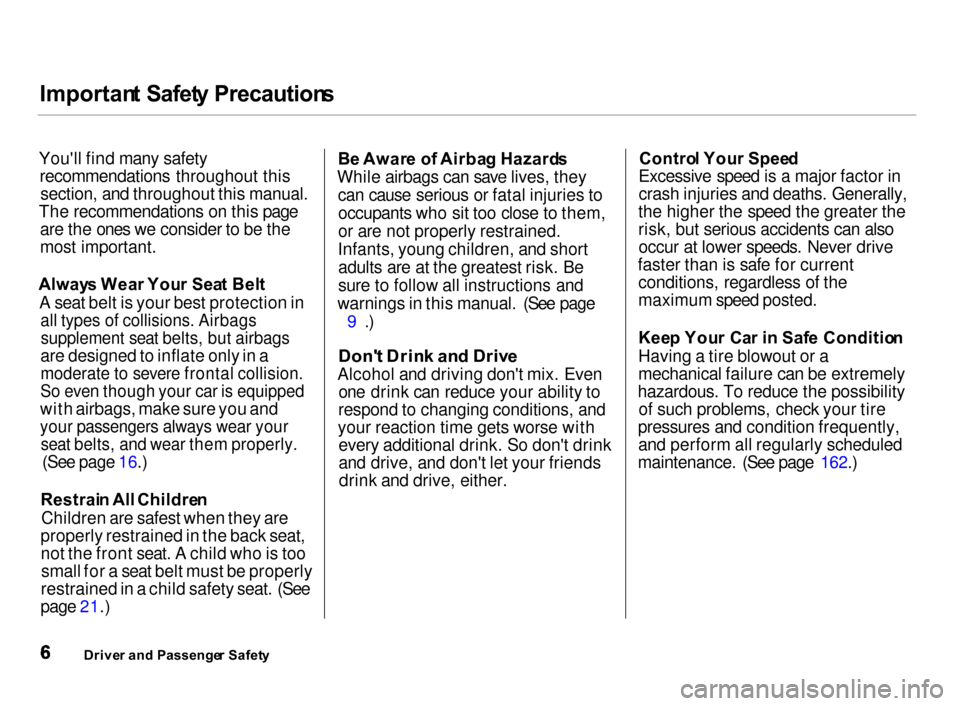
Importan
t Safet y Precaution s
You'll find many safety recommendations throughout thissection, and throughout this manual.
The recommendations on this page are the ones we consider to be the
most important.
Alway s Wea r You r Sea t Bel t
A seat belt is your best protection in
all types of collisions. Airbags
supplement seat belts, but airbags
are designed to inflate only in a
moderate to severe frontal collision.
So even though your car is equipped
with airbags, make sure you and
your passengers always wear your
seat belts, and wear them properly.
(See page 16.)
Restrai n All Childre n
Children are safest when they are
properly restrained in the back seat, not the front seat. A child who is toosmall for a seat belt must be properly
restrained in a child safety seat. (See
page 21.) B
e Awar e o f Airba g Hazard s
While airbags can save lives, they can cause serious or fatal injuries tooccupants who sit too close to them,
or are not properly restrained.
Infants, young children, and short adults are at the greatest risk. Be
sure to follow all instructions and
warnings in this manual. (See page 9 .)
Don' t Drin k an d Driv e
Alcohol and driving don't mix. Even one drink can reduce your ability to
respond to changing conditions, and
your reaction time gets worse with every additional drink. So don't drink
and drive, and don't let your friendsdrink and drive, either. Contro
l You r Spee d
Excessive speed is a major factor in
crash injuries and deaths. Generally,
the higher the speed the greater the
risk, but serious accidents can also occur at lower speeds. Never drive
faster than is safe for current conditions, regardless of the
maximum speed posted.
Kee p You r Ca r i n Saf e Conditio n
Having a tire blowout or a
mechanical failure can be extremely
hazardous. To reduce the possibility of such problems, check your tire
pressures and condition frequently, and perform all regularly scheduled
maintenance. (See page 162.)
Drive r an d Passenge r Safet y
Page 149 of 279
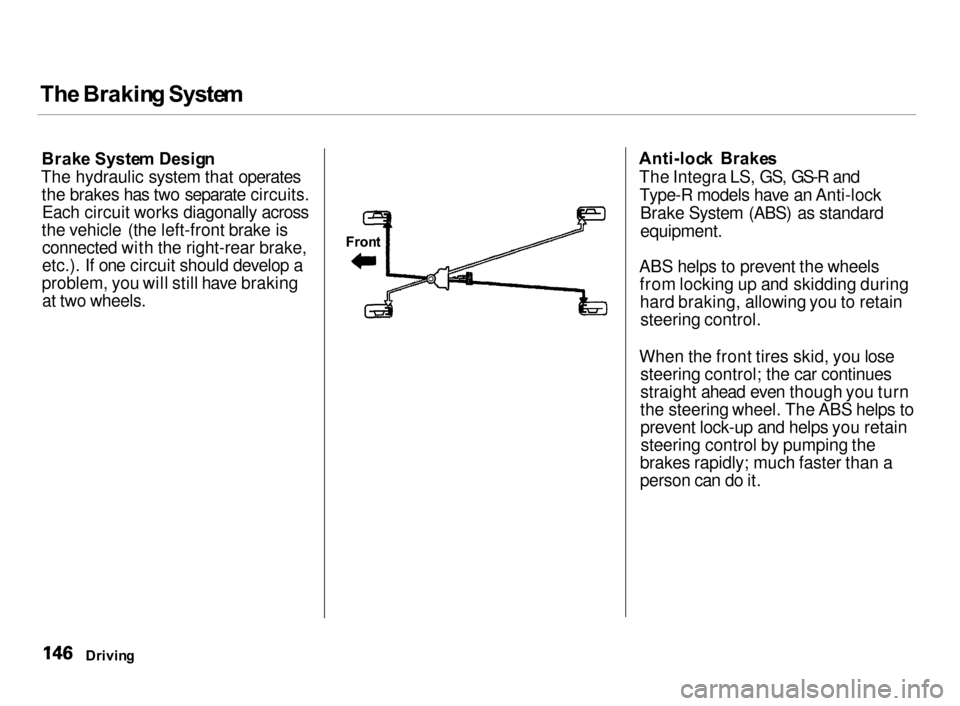
Th
e Brakin g Syste m
Brak e Syste m Desig n
The hydraulic system that operates the brakes has two separate circuits.Each circuit works diagonally across
the vehicle (the left-front brake is connected with the right-rear brake,
etc.). If one circuit should develop a
problem, you will still have braking at two wheels.
Fron
t
Anti-loc
k Brake s
The Integra LS, GS, GS-R and Type-R models have an Anti-lock Brake System (ABS) as standard
equipment.
ABS helps to prevent the wheels from locking up and skidding duringhard braking, allowing you to retainsteering control.
When the front tires skid, you lose steering control; the car continues
straight ahead even though you turn
the steering wheel. The ABS helps to
prevent lock-up and helps you retainsteering control by pumping the
brakes rapidly; much faster than a
person can do it.
Drivin g
Page 154 of 279
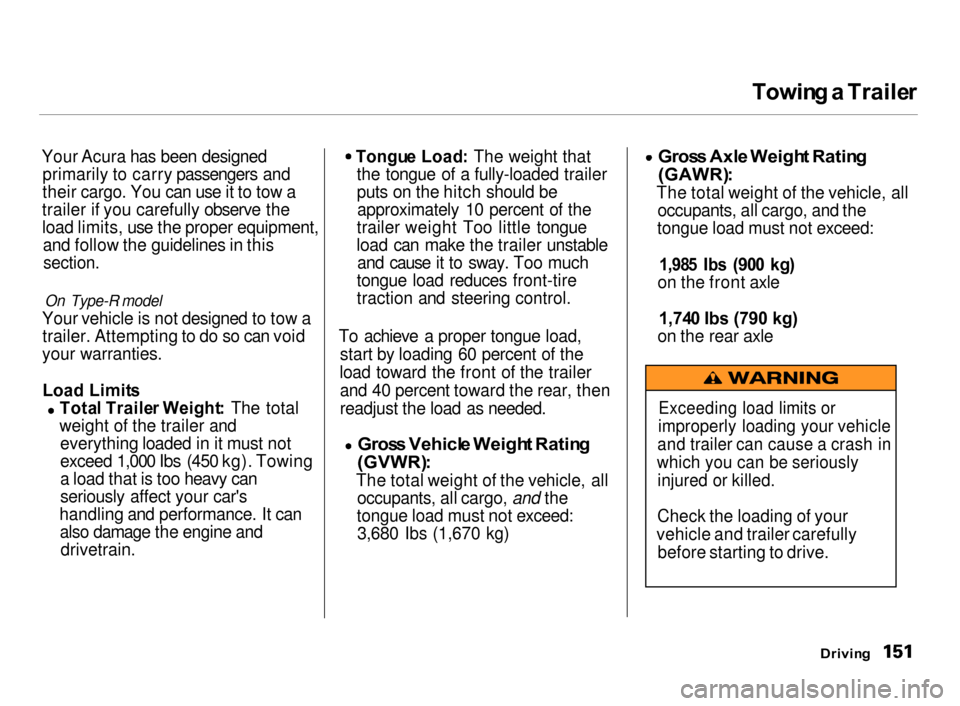
Towin
g a Traile r
Your Acura has been designed primarily to carry passengers and
their cargo. You can use it to tow a
trailer if you carefully observe the
load limits, use the proper equipment, and follow the guidelines in this
section.
On Type-R model
Your vehicle is not designed to tow a trailer. Attempting to do so can void
your warranties.
Load Limit s
Tota l Traile r Weight : The total
weight of the trailer and everything loaded in it must not
exceed 1,000 Ibs (450 kg). Towing
a load that is too heavy can
seriously affect your car's
handling and performance. It can also damage the engine and drivetrain. Tongu
e Load : The weight that
the tongue of a fully-loaded trailer
puts on the hitch should be approximately 10 percent of the
trailer weight Too little tongue
load can make the trailer unstable and cause it to sway. Too much
tongue load reduces front-tire
traction and steering control.
To achieve a proper tongue load, start by loading 60 percent of the
load toward the front of the trailer and 40 percent toward the rear, then
readjust the load as needed.
Gros
s Vehicl e Weigh t Ratin g
(GVWR) :
The total weight of the vehicle, all occupants, all cargo, and the
tongue load must not exceed: 3,680 Ibs (1,670 kg)
Gros
s Axl e Weigh t Ratin g
(GAWR) :
The total weight of the vehicle, all occupants, all cargo, and the
tongue load must not exceed:1,98 5 Ib s (90 0 kg )
on the front axle
1,740 Ibs (790 kg)
on the rear axle
Driving
Exceeding load limits or
improperly loading your vehicle
and trailer can cause a crash in
which you can be seriously
injured or killed.
Check the loading of your
vehicle and trailer carefully before starting to drive.
Page 199 of 279
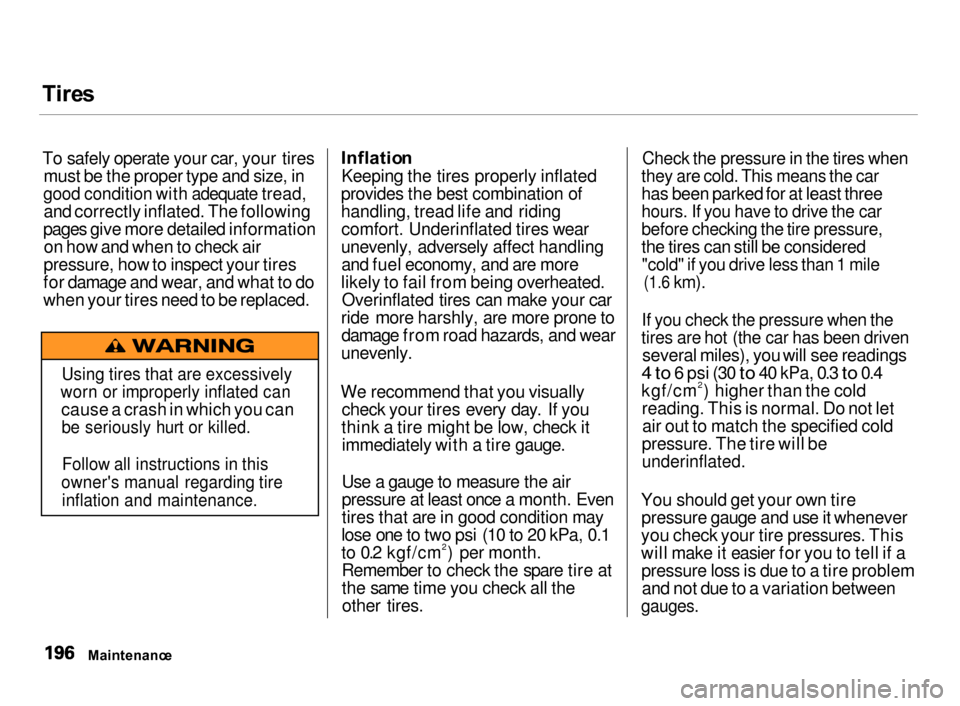
Tire
s
To safely operate your car, your tires must be the proper type and size, in
good condition with adequate tread,
and correctly inflated. The following
pages give more detailed information on how and when to check air
pressure, how to inspect your tires
for damage and wear, and what to do
when your tires need to be replaced.
Inflatio
n
Keeping the tires properly inflated
provides the best combination of
handling, tread life and riding comfort. Underinflated tires wear
unevenly, adversely affect handling and fuel economy, and are more
likely to fail from being overheated. Overinflated tires can make your car
ride more harshly, are more prone to damage from road hazards, and wear
unevenly.
We recommend that you visually check your tires every day. If you
think a tire might be low, check it immediately with a tire gauge.
Use a gauge to measure the air
pressure at least once a month. Even
tires that are in good condition may
lose one to two psi (10 to 20 kPa, 0.1
to 0.2 kgf/cm2) per month. Remember to check the spare tire at
the same time you check all theother tires.
Check the pressure in the tires when
they are cold. This means the car
has been parked for at least three
hours. If you have to drive the car
before checking the tire pressure,
the tires can still be considered
"cold" if you drive less than 1 mile
(1.6
km).
If you check the pressure when the
tires are hot (the car has been driven
several miles), you will see readings
4 to
6 psi (30
to
40
kPa,
0.3
to
0.4
kgf/cm2) higher than the cold reading. This is normal. Do not letair out to match the specified cold
pressure. The tire will be
underinflated.
You should get your own tire pressure gauge and use it whenever
you check your tire pressures. This
will make it easier for you to tell if a pressure loss is due to a tire problemand not due to a variation between
gauges.
Maintenanc e
Using tires that are excessively
worn or improperly inflated can
cause a crash in which you can
be seriously hurt or killed.
Follow all instructions in this
owner's manual regarding tire
inflation and maintenance.
Page 202 of 279
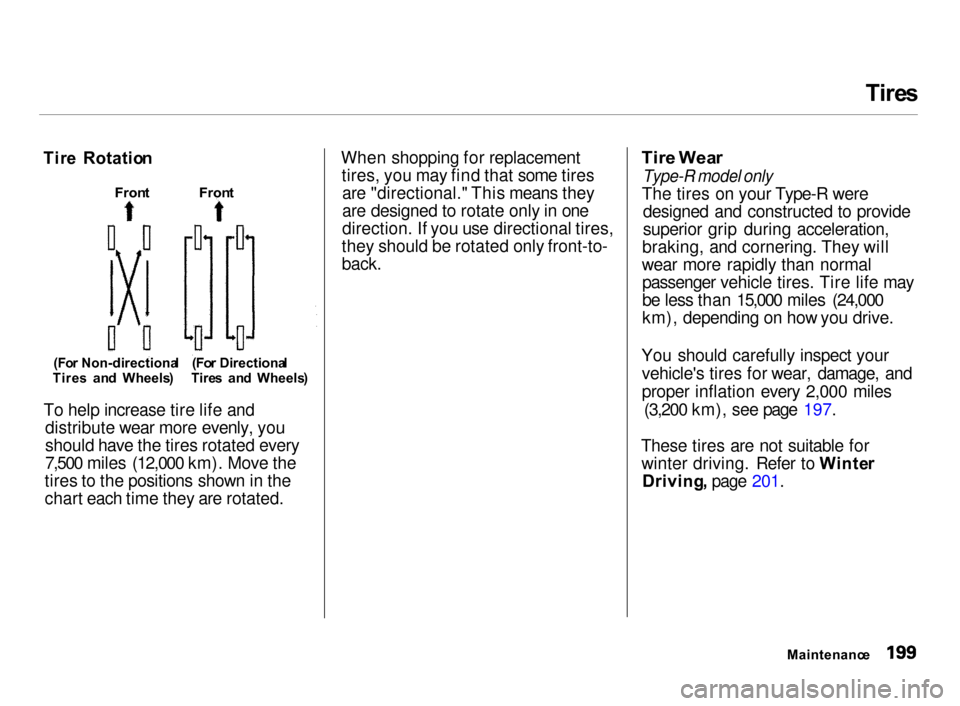
Tire
s
Tir e Rotatio n
To help increase tire life and distribute wear more evenly, you
should have the tires rotated every
7,500 miles (12,000 km). Move the
tires to the positions shown in the
chart each time they are rotated. When shopping for replacement
tires, you may find that some tiresare "directional." This means they
are designed to rotate only in one
direction. If you use directional tires,
they should be rotated only front-to-
back.
Tir
e Wea r
Type-R model only
The tires on your Type-R were
designed and constructed to provide
superior grip during acceleration,
braking, and cornering. They will
wear more rapidly than normal passenger vehicle tires. Tire life may
be less than 15,000 miles (24,000
km), depending on how you drive.
You should carefully inspect your vehicle's tires for wear, damage, and
proper inflation every 2,000 miles (3,200 km), see page 197.
These tires are not suitable for winter driving. Refer to Winte r
Driving , page 201.
Maintenance
Fron
t Front
(Fo r Non-directiona l
Tires an d Wheels )
(Fo r Directiona l
Tires an d Wheels )
Page 203 of 279
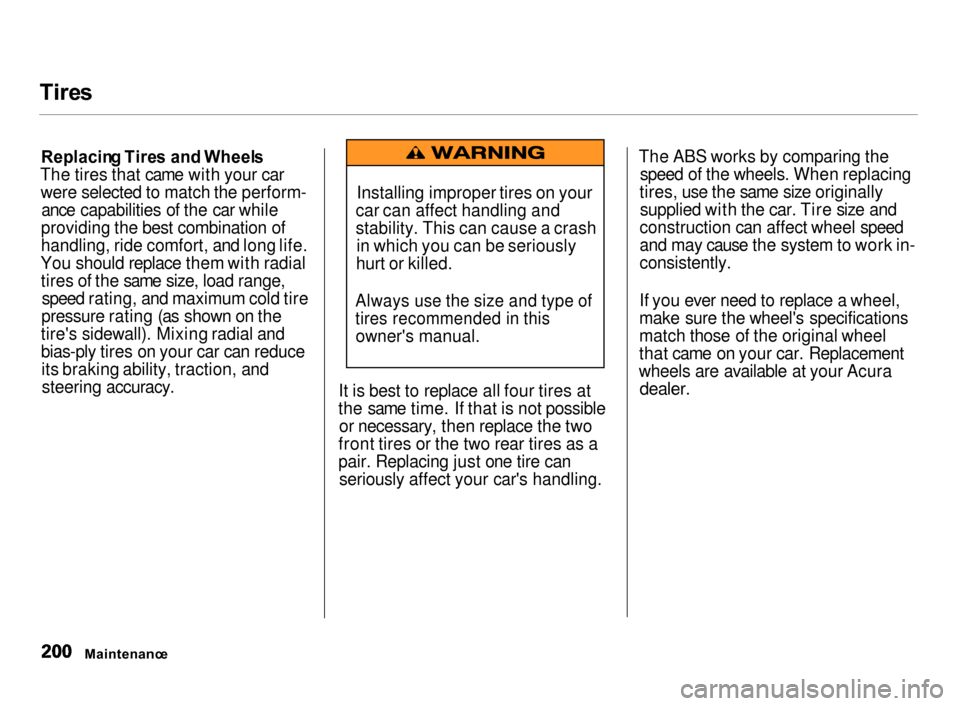
Tire
s
Replacin g Tire s an d Wheel s
The tires that came with your car were selected to match the perform- ance capabilities of the car while
providing the best combination of
handling, ride comfort, and long life.
You should replace them with radial tires of the same size, load range, speed rating, and maximum cold tire
pressure rating (as shown on the
tire's sidewall). Mixing radial and
bias-ply tires on your car can reduce its braking ability, traction, andsteering accuracy. It is best to replace all four tires at
the same time. If that is not possible or necessary, then replace the two
front tires or the two rear tires as a
pair. Replacing just one tire can seriously affect your car's handling. The ABS works by comparing the
speed of the wheels. When replacing
tires, use the same size originally supplied with the car. Tire size and
construction can affect wheel speed
and may cause the system to work in-
consistently.
If you ever need to replace a wheel,
make sure the wheel's specifications
match those of the original wheel
that came on your car. Replacement
wheels are available at your Acura
dealer.
Maintenanc e
Installing improper tires on your
car can affect handling and
stability. This can cause a crash in which you can be seriously
hurt or killed.
Always use the size and type of
tires recommended in this
owner's manual.
Page 204 of 279
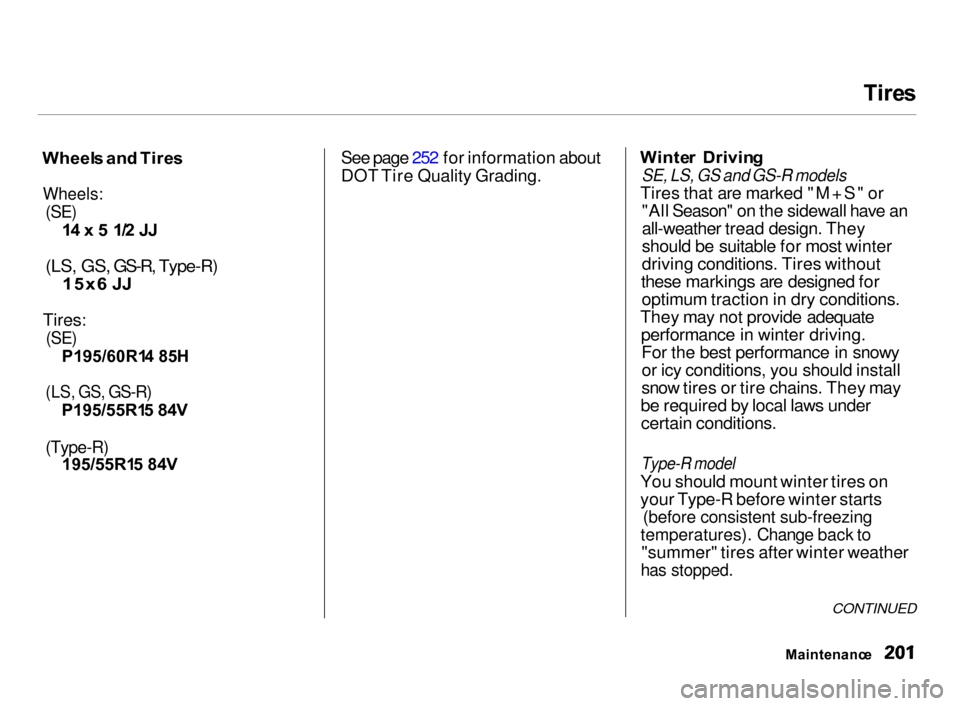
Tire
s
Wheel s an d Tire s
Wheels:
(SE)
14 x 5 1/ 2 J J
(LS, GS, GS-R, Type-R)
15x6 JJ
Tires:
(SE)
P195/60R1 4 85 H
(LS,
GS,
GS-R)
P195/55R1 5 84 V
(Type-R)
195/55R1 5 84 V
See page 252 for information about
DOT Tire Quality Grading.
Winte
r Drivin g
SE, LS, GS and GS-R models
Tires that are marked "M+S" or "All Season" on the sidewall have an
all-weather tread design. They
should be suitable for most winter
driving conditions. Tires without
these markings are designed for optimum traction in dry conditions.
They may not provide adequate performance in winter driving.For the best performance in snowyor icy conditions, you should install
snow tires or tire chains. They may
be required by local laws under certain conditions.
Type-R model
You should mount winter tires on
your Type-R before winter starts
(before consistent sub-freezing
temperatures). Change back to
"summer" tires after winter weather
has stopped.
Maintenance
CONTINUED
Page 205 of 279
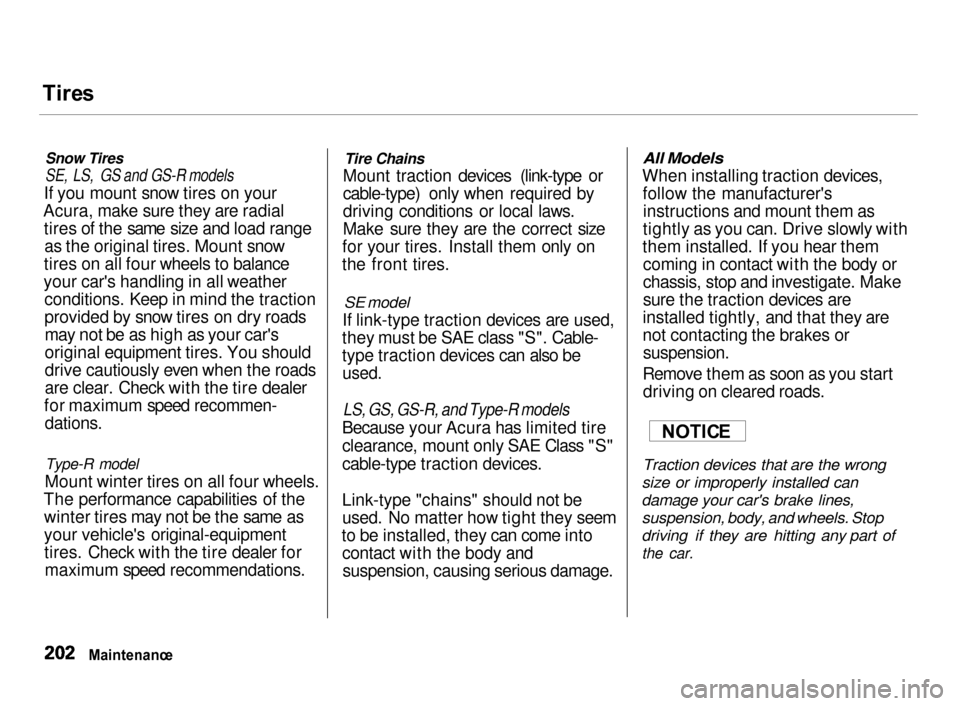
Tire
s
Snow Tires
SE, LS, GS and GS-R models
If you mount snow tires on your
Acura, make sure they are radial tires of the same size and load rangeas the original tires. Mount snow
tires on all four wheels to balance
your car's handling in all weather conditions. Keep in mind the traction
provided by snow tires on dry roadsmay not be as high as your car's
original equipment tires. You should
drive cautiously even when the roads
are clear. Check with the tire dealer
for maximum speed recommen-
dations.
Type-R model
Mount winter tires on all four wheels.
The performance capabilities of the winter tires may not be the same as
your vehicle's original-equipmenttires. Check with the tire dealer formaximum speed recommendations. Tire Chains
Mount traction devices (link-type or
cable-type) only when required by
driving conditions or local laws.
Make sure they are the correct size
for your tires. Install them only on
the front tires.
SE model
If link-type traction devices are used,
they must be SAE class "S". Cable-
type traction devices can also be
used.
LS, GS, GS-R, and Type-R models
Because your Acura has limited tire
clearance, mount only SAE Class "S"
cable-type traction devices.
Link-type "chains" should not be
used. No matter how tight they seem
to be installed, they can come into contact with the body andsuspension, causing serious damage.
All Models
When installing traction devices, follow the manufacturer'sinstructions and mount them as
tightly as you can. Drive slowly with
them installed. If you hear them coming in contact with the body or
chassis, stop and investigate. Make
sure the traction devices are
installed tightly, and that they are
not contacting the brakes or
suspension.
Remove them as soon as you start driving on cleared roads.
Traction devices that are the wrong
size or improperly installed can
damage your car's brake lines,
suspension, body, and wheels. Stop
driving if they are hitting any part of
the car.
Maintenanc e
NOTIC
E
Page 227 of 279
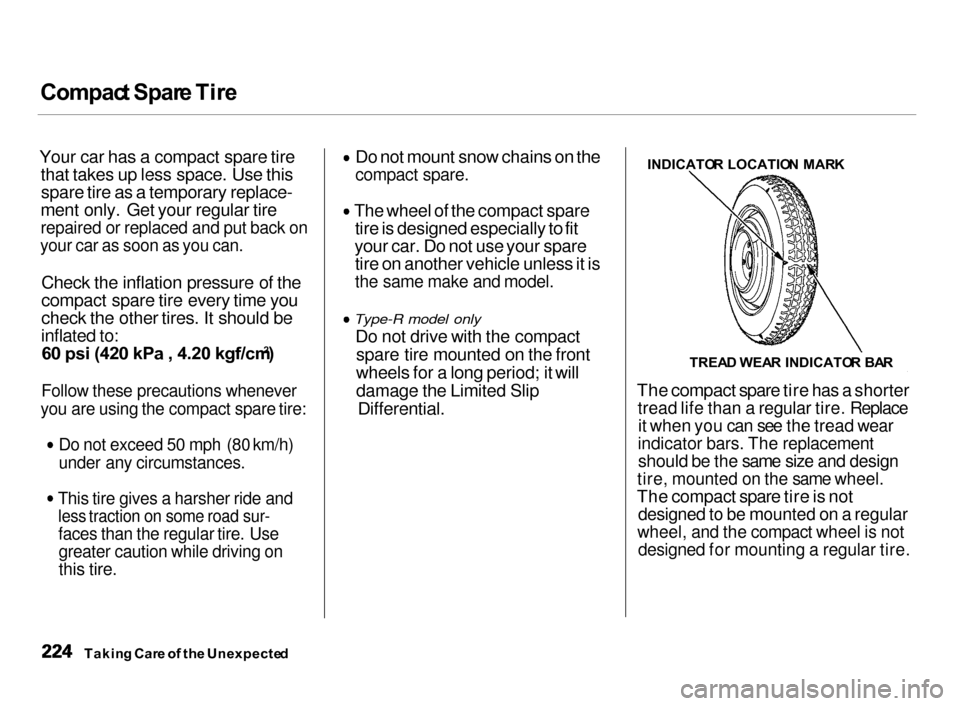
Compac
t Spar e Tir e
Your car has a compact spare tire that takes up less space. Use thisspare tire as a temporary replace-
ment only. Get your regular tirerepaired or replaced and put back on
your car as soon as you can.
Check the inflation pressure of the
compact spare tire every time you
check the other tires. It should be
inflated to:
60 psi (420 kPa , 4.20 kgf/cm2)
Follow these precautions whenever
you are using the compact spare tire:
Do not exceed 50 mph (80 km/h)
under any circumstances.
This tire gives a harsher ride and
less traction on some road sur-
faces than the regular tire. Use greater caution while driving on
this tire. Do not mount snow chains on the
compact spare.
The wheel of the compact spare tire is designed especially to fit
your car. Do not use your spare tire on another vehicle unless it is
the same make and model.
Type-R model only
Do not drive with the compactspare tire mounted on the front
wheels for a long period; it will damage the Limited Slip Differential. The compact spare tire has a shorter
tread life than a regular tire. Replace
it when you can see the tread wear
indicator bars. The replacement
should be the same size and design
tire, mounted on the same wheel.
The compact spare tire is not
designed to be mounted on a regular
wheel, and the compact wheel is not
designed for mounting a regular tire.
Takin g Car e o f th e Unexpecte d INDICATO
R LOCATIO N MAR K
TREA D WEA R INDICATO R BA R
Page 231 of 279
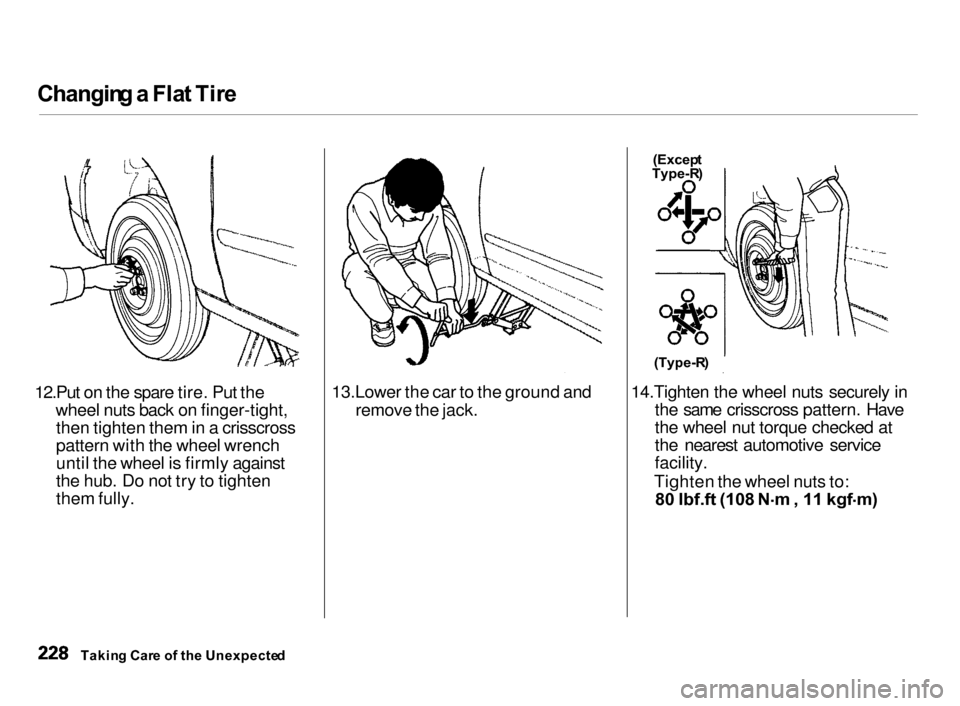
Changin
g a Fla t Tir e
12.Put on the spare tire. Put the
wheel nuts back on finger-tight, then tighten them in a crisscross
pattern with the wheel wrench
until the wheel is firmly against
the hub. Do not try to tighten
them fully.
13.Lower the car to the ground and
remove the jack.
14.Tighten the wheel nuts securely in
the same crisscross pattern. Have
the wheel nut torque checked at
the nearest automotive service
facility.
Tighten the wheel nuts to: 80 lbf.ft (108 N.
m , 11 kgf .
m)
Takin g Car e o f th e Unexpecte d
(Excep
t
Type-R )
(Type-R )